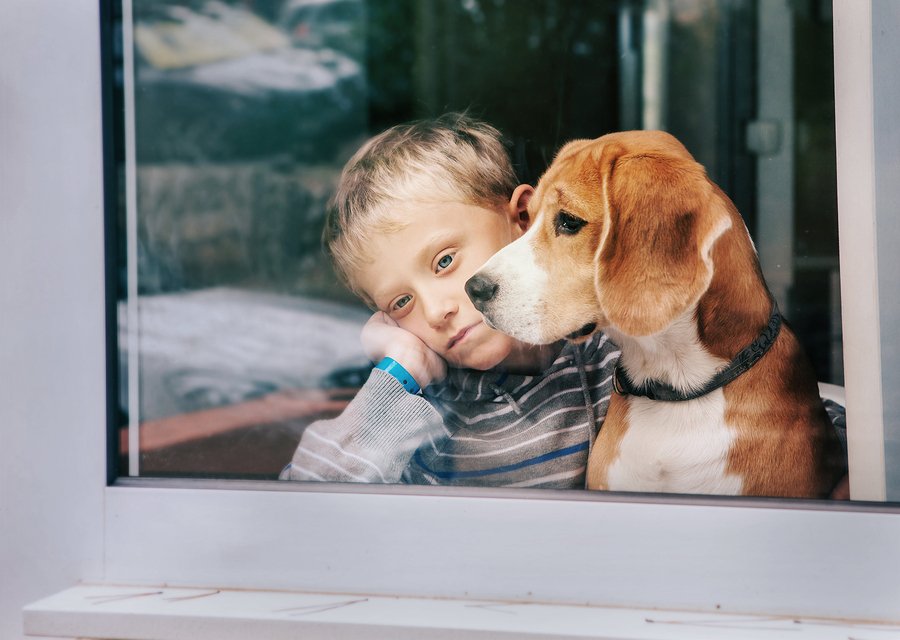The statistics speak for themselves. Seventy-two percent of pet-owning women who find safety in a women’s shelter report that their abuser had also injured, maimed, killed, or threatened family pets for revenge or to psychologically control. Furthermore, 32 percent of the children who end up in shelters to escape domestic abuse have themselves harmed or even killed dogs or other animals; the lessons modeled by the offending adult seep in insidiously.
The numbers were compiled by the American Humane Association in conjunction with the National Coalition Against Domestic Violence. But they represent only those who make it to safety. As many as 40 percent of battered women do not leave their abuser out of fear of what might happen to their dog, other pet, or livestock once they have gone.
Indeed, the will-breaking that makes it difficult to escape an abusive relationship becomes even harder if there is a dog involved who has served as a source of comfort and has also been a target of abuse. No one wants to escape but leave behind a four-legged loved one. Logistic challenges hinder efforts to get away, too. Those battered may very much want to take the dog with them but often assume they won’t be allowed sanctuary if they bring their pet. Or they believe that keeping their pet in a separate safe haven for a while is not an option. Making the situation more desperate still is that abusers frequently up the ante specifically by threatening to harm a cherished dog.


Dog as hostage
“We hear from many victims who share that their partners…have threatened to shoot their pets if the victim leaves,” says National Domestic Violence Hotline Chief Communications Officer Cameka Crawford. “Because so many victims have strong emotional bonds with their pets, especially if they have been isolated by their abusive partner, they often express hesitation about leaving their pets behind.”
Their fear is born of all-too-real experience. Of the women who report abuse of their pets by an intimate partner, nine in 10 of them report having personally witnessed the abuse, as have 75 percent of children from such homes. The abuse is designed to “psychologically control and coerce them,” says the American Humane Association on its website (americanhumane.org).
Some victims who do find the wherewithal to leave are so inextricably (and understandably) bound by comfort and shared abuse with their dog that they “have been known to live in their cars with their pets for as long as four months until an opening was available at a pet-friendly safe house,” the association reports.
Getting help is made harder by the tendency to conceal abuse. Victims will sooner admit to their pet’s abuse than their own. But therein lies a sad truth that, ironically, can make a dog a light in a tunnel, so to speak. Often enough, an ongoing domestic abuse situation is uncovered during an investigation of an animal cruelty tip, according to the California-based Animal Legal Defense Fund. That is, checking into the abuse of a dog can end up saving an abused person.
Protections for dogs coming into place
Fortunately, legislators are stepping up to address the issue of dogs and other animals who get caught up in dangerous domestic situations, affording protection to both abused pets and the people who love them and don’t want to leave them behind or get them enmeshed in their personal melee. Maine became the first state to enact a statute addressing the issue back in 2006 with its Domestic Abuse Animal Protection Act. The law essentially allows judges to include pets in domestic violence protection orders, meaning it is illegal for an abuser to take revenge on a pet. New York soon followed suit and to date, some 30 states have enacted similar legislation.
That’s a great help, but the question of where to go for safety without having to give up your dog is paramount. Solutions for that, too, are growing.
The Humane Society of the United States has on its site a Directory of Safe Havens for Animals Programs with a list of shelters that will board pets of women fleeing domestic violence. There are also listings of shelters that take people but are pet-friendly, too, meaning that they will allow residents to keep their pets with them. But you’re not necessarily out of luck if you don’t see a program near you. The Humane Society notes that “if you don’t see a program listed in your area, contact your local domestic violence shelter, animal shelter, veterinarian, or boarding kennel to see if they have a safe-haven-for-animals program or can provide temporary care for your pet.”
One of the many animal shelters listed on the directory is the Santa Ynez Valley Humane Society in Buellton, California. It does not typically get calls requesting a safe haven for a dog or other pet, says executive director Seth Hutson. But a system is in place to provide needed help. Mr. Hutson says the facility “would gladly board the pet without hesitation until the victim could figure out what to do,” most likely waiving the fee outright or at least providing a steep discount.


“We would take the pet, let the victim take a few days to breathe — it is a very courageous thing to leave — and after a few days of collecting her thoughts, she can come and discuss the short- and long-term needs of her pet. Paperwork can always be resolved later, but the immediate thing is to get the pet in here so the woman can be removed from that dangerous situation.”
If the dog is what is referred to as a “red zone” dog, meaning that the pet has special medical needs, the shelter would transfer it to the county, which is better equipped to provide appropriate care, says Mr. Hutson.
To Mary Silver, Volunteer/Program Coordinator for The ARK Shelter, serving Brown, Coleman and Comanche Counties in Texas, it is not surprising that Mr. Hutson would express a readiness to step up to assist. She expects that other animal shelters would want to do the same, whether listed in a safe-havens directory or not. Luckily for those who make their way to The ARK Shelter, no painful separation from their pet, even temporarily, is part of the scenario. That facility serves women as well as their dogs.
Such people-and-pet shelters are a particular godsend. For those fleeing violent abusers, the bond with their dog can be so sustaining that to be separated is almost crippling. Consider that victims cling to their dogs not only because of their bond or their desire to keep them safe but also because pets represent the normal life with comfort and safety that has been wrenched from them. It is wonderful for those escaping abuse to be able to remain with their pets, their piece of normalcy, as they begin the process of rebuilding their lives.
Educating and publicizing are key
Along with helping victims of abuse directly, the ARK Shelter regularly provides educational materials at public events, to EMTs, to law enforcement, doctors and nurses, and anyone else who might be on the front lines of domestic violence situations, right down to the small child who leaves an event with a free pencil embossed with the shelter’s name and contact number.
It’s not just soft PR. The ARK’s Ms. Silver would like to see an understanding of the link between domestic violence and violence toward pets become more commonplace — and thereby, less acceptable in the public eye. She likens the initiative to what Mothers Against Drunk Driving (MADD) did to change the perception of driving while intoxicated. Juries once didn’t tend to convict drunk drivers because they were “members of the community,” perhaps otherwise “upstanding citizens.” Now they do. Drunk driving is a recognized offense understood to have potentially serious, even deadly, consequences involving innocent people.
Part of the education is that while the first image that comes to mind when hearing about domestic violence is a girlfriend or wife, there are many types of victims. Ms. Silver points out that her pet-friendly shelter takes in seniors whose drug-addicted grandchildren have taken over the home, becoming violent when they can’t have the car or social security check; members of the gay and transgender community who have met with violence, including violence at home; and so on.
“Perhaps it’s your son or daughter, a nephew or niece, or a neighbor or friend in this situation,” says Ms. Silver. “We want people to speak up, to start saying something when they know what’s going on next door, and assist when someone confides in them. It has to stop,” both for people and their dogs.





